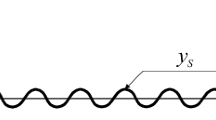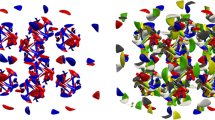Abstract
In this paper, we apply a simple finite element numerical scheme, proposed in an earlier work (Liu in Math Comput 70(234):579–593, 2000), to perform a high resolution numerical simulation of incompressible flow over an irregular domain and analyze its boundary layer separation. Compared with many classical finite element fluid solvers, this numerical method avoids a Stokes solver, and only two Poisson-like equations need to be solved at each time step/stage. In addition, its combination with the fully explicit fourth order Runge–Kutta (RK4) time discretization enables us to compute high Reynolds number flow in a very efficient way. As an application of this robust numerical solver, the dynamical mechanism of the boundary layer separation for a triangular cavity flow with Reynolds numbers \(Re=10^4\) and \(Re=10^5\), including the precise values of bifurcation location and critical time, are reported in this paper. In addition, we provide a super-convergence analysis for the simple finite element numerical scheme, using linear elements over a uniform triangulation with right triangles.






















Similar content being viewed by others
Explore related subjects
Discover the latest articles and news from researchers in related subjects, suggested using machine learning.References
Auteri, F., Parolini, N., Quartapelle, L.: Numerical investigation on the stability of singular driven cavity flow. J. Comput. Phys. 183, 1–25 (2002)
Barragy, E., Carey, G.F.: Stream function-vorticity driven cavity solution using \(p\) finite elements. Comput. Fluids 26(5), 453–468 (1997)
Boffi, D., Brezzi, F., Fortin, M.: Mixed Finite Element Methods and Applications. Springer, Berlin (2013)
Brenner, S., Scott, L.: The Mathematical Theory of Finite Element Methods, 3rd edn. Springer, Berlin (2010)
Bruneau, C.-H., Saad, M.: The 2D lid-driven cavity problem revisited. Comput. Fluids 35, 326–348 (2006)
Chorin, A.J., Marsden, J.E.: A Mathematical Introduction to Fluid Mechanics. Springer, Berlin (1997)
Ciarlet, P.: The Finite Element Method for Elliptic Problems. North-Holland, Amsterdam (1978)
Cockburn, B., Kanschat, G., Schötzau, D.: A locally conservative LDG method for the incompressible Navier–Stokes equations. Math. Comput. 74, 1067–1095 (2005)
Coupez, T., Hachem, E.: Solution of high-Reynolds incompressible flow with stabilized finite element and adaptive anisotropic meshing. Comput. Methods Appl. Mech. Eng. 267, 65–85 (2013)
Di, Y., Li, R., Tang, T., Zhang, P.: Moving mesh finite element methods for the incompressible Navier–Stokes equations. SIAM J. Sci. Comput. 26, 1036–1056 (2005)
E, W., Liu, J.-G.: Essentially compact schemes for unsteady viscous incompressible flows. J. Comput. Phys. 126, 122–138 (1996)
E, W., Liu, J.-G.: Vorticity boundary condition and related issues for finite difference schemes. J. Comput. Phys. 124, 368–382 (1996)
Erturk, E., Corke, T., Gokcol, C.: Numerical solutions of 2D steady incompressible driven cavity flow at high Reynolds numbers. Int. J. Numer. Methods Fluids 48, 747–774 (2005)
Erturk, E., Gokcol, O.: Fine grid numerical solutions of triangular cavity flow. Eur. Phys. J. Appl. Phys. 38, 97–105 (2007)
China Fegensoft software company. http://www.fegensoft.com.cn
Center for Applied Scientific Computing of Lawrence Livermore National Lab. https://computation-rnd.llnl.gov/linear_solvers/software.php
Gargano, F., Sammartino, M., Sciacca, V.: High Reynolds number Navier–Stokes solutions and boundary layer separation induced by a rectilinear vortex. Comput. Fluids 52, 73–91 (2011)
Ge, L., Sotiropoulos, F.: A numerical method for solving the 3D unsteady incompressible Navier–Stokes equations in curvilinear domains with complex immersed boundaries. J. Comput. Phys. 225, 1782–1809 (2007)
George, A., Huang, L.C., Tang, W., Wu, Y.: Numerical simulation of unsteady incompressible flow \((Re\le 9500)\) on the curvilinear half-staggered mesh. SIAM J. Sci. Comput. 21(6), 2331–2351 (2000)
Ghia, U., Ghia, K., Shin, C.: High-Re solutions for incompressible flow using the Navier–Stokes equations and a multigrid method. J. Comput. Phys 48, 387–411 (1982)
Ghil, M., Liu, J.-G., Wang, C., Wang, S.: Boundary-layer separation and adverse pressure gradient for 2-D viscous incompressible flow. Phys. D 197, 149–173 (2004)
Ghil, M., Ma, T., Wang, S.: Structure of 2-D incompressible flows with the Dirichlet boundary conditions. Discrete Contin. Dyn. Syst. B 1, 29–41 (2001)
Ghil, M., Ma, T., Wang, S.: Structural bifurcation of 2-D nondivergent flows with Dirichlet boundary condition: applications to boundary-layer separation. SIAM J. Appl. Math. 65(5), 1576–1596 (2005)
Girault, V., Raviart, P.: Finite Element Method for Navier–Stokes Equations: Theory and Algorithms. Springer, Berlin (1986)
Girault, V., Riviére, B., Wheeler, M.F.: A discontinuous Galerkin method with nonoverlapping domain decomposition for the Stokes and Navier–Stokes problems. Math. Comput. 74, 53–84 (2005)
Goldstein, S.: Modern Developments in Fluid Fynamics. Dover Publications, New York (1965)
Gonzalez, L.M., Ahmed, M., Kuhnen, J.: Three-dimensional flow instability in a lid-driven isosceles triangular cavity. J. Fluid Mech. 675, 369–396 (2011)
Hachem, E., Rivaux, B., Kloczko, T., Digonnet, H., Coupez, T.: Stabilized finite element method for incompressible flows with high Reynolds number. J. Comput. Phys. 229, 8643–8665 (2010)
He, Y.: Euler implicit/explicit iterative scheme for the stationary Navier–Stokes equations. Numer. Math. 123, 67–96 (2013)
Heywood, J., Rannacher, R.: Finite element approximation of the nonstationary Navier–Stokes problem. I. Regularity of solutions and second-order error estimates for spatial discretization. SIAM J. Numer. Anal. 19, 275–310 (1982)
Holdeman, J.T.: A Hermite finite element for incompressible fluid flow. Int. J. Numer. Methods Fluids 64, 376–408 (2010)
Huang, Y., Liu, J.-G., Wang, W.: A generalized MAC scheme on curvilinear domains. SIAM J. Sci. Comput. 35(5), 953–986 (2013)
Jagannathan, A., Mohan, R., Dhanak, M.: A spectral method for the triangular cavity flow. Comput. Fluids 95, 40–48 (2014)
Johnston, H., Liu, J.-G.: A finite difference scheme for incompressible flow based on local pressure boundary conditions. J. Comput. Phys. 180, 120–154 (2002)
Johnston, H., Liu, J.-G.: Accurate, stable and efficient Navier–Stokes solvers based on explicit treatment of the pressure term. J. Comput. Phys. 199, 221–259 (2004)
Kalita, J.C., Sen, S.: The biharmonic approach for unsteady flow past an impulsively started circular cylinder. Commun. Comput. Phys. 12, 1163–1182 (2012)
Koumoutsakost, P., Leonard, A.: High-resolution simulations of the flow around an impulsively started cylinder using vortex methods. J. Fluid Mech. 296, 1–38 (1995)
Lai, M.-J., Wenston, P.: Bivariate splines for fluid flows. Comput. Fluids 33, 1047–1073 (2004)
Layton, W., Lee, H., Peterson, J.: A defect-correction method for the incompressible Navier–Stokes equations. Appl. Math. Comput. 129, 1–19 (2002)
Li, M., Tang, T.: Steady viscous flow in a triangular cavity by efficient numerical techniques. Comput. Math. Appl. 31(10), 55–65 (1996)
Li, Z., Wang, C.: A fast finite difference method for solving Navier–Stokes equations on irregular domains. Commun. Math. Sci. 1(1), 181–197 (2003)
Lin, Q., Yan, N.: Structure and Analysis for Efficient Finite Element Methods. Publishers of Hebei University, Baoding (1996). (in Chinese)
Liu, J.-G., E, W.: Simple finite element methods in vorticity formulation for incompressible flows. Math. Comput. 70(234), 579–593 (2000)
Oleinik, O.A., Samokhin, V.N.: Mathematical Models in Boundary Layer Theory. Chapman and Hall, London (1999)
Rannacher, R., Scott, R.: Some optimal error estimates for piecewise linear finite element approximations. Math. Comput. 38, 437–445 (1982)
Rhebergen, S., Cockburn, B., van der Vegt, J.J.W.: A space–time discontinuous Galerkin method for the incompressible Navier–Stokes equations. J. Comput. Phys. 233, 339–358 (2013)
Ribbens, C.J., Watson, L.T., Wang, C.-Y.: Steady viscous flow in a triangular cavity. J. Comput. Phys. 112(1), 173–181 (1994)
Shahbazi, K., Fischer, P.F., Ethier, C.R.: A high-order discontinuous Galerkin method for the unsteady incompressible Navier–Stokes equations. J. Comput. Phys. 222, 391–407 (2007)
Wang, K., Wong, Y.S.: Error correction method for Navier–Stokes equations at high Reynolds numbers. J. Sci. Comput. 255, 245–265 (2013)
Yan, N.: Superconvergence Analysis and a Posteriori Error Estimation in Finite Element Methods. Science Press, China (2005)
Acknowledgments
The authors greatly appreciate many helpful discussions with Wenbin Chen, Sigal Gottlieb, Yuan Liu and Chi-Wang Shu, in particular for their insightful suggestion and comments. This work is supported in part by the NSF DMS-1115420 NSF DMS-1418689 (C. Wang), NSFC 11271281 (C. Wang), NSFC 11171168 (Y. Xue) and the fund by China Scholarship Council (Y. Xue). Y. Xue thanks University of Massachusetts Dartmouth, for support during his visit. C. Wang also thanks Shanghai Center for Mathematical Sciences and Shanghai Key Laboratory for Contemporary Applied Mathematics, Fudan University, for support during his visit.
Author information
Authors and Affiliations
Corresponding author
Rights and permissions
About this article
Cite this article
Xue, Y., Wang, C. & Liu, JG. Simple Finite Element Numerical Simulation of Incompressible Flow Over Non-rectangular Domains and the Super-Convergence Analysis. J Sci Comput 65, 1189–1216 (2015). https://doi.org/10.1007/s10915-015-0005-8
Received:
Revised:
Accepted:
Published:
Issue Date:
DOI: https://doi.org/10.1007/s10915-015-0005-8
Keywords
- Incompressible flows
- Boundary layer separation
- Structural bifurcation
- Simple finite element method
- Super-convergence analysis




